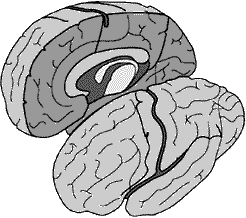It Seems The Beatles Were on to Something.
The year is 1966. After months of extensive preparation and creative troubleshooting, three scientists studying the brain’s unique split personality eagerly awaited the results of their carefully designed experiment. By placing an electrode into a cat’s corpus callosum, they were hoping to decode the brain’s elusive internal code. What they ended up finding was something much more profound, and much more revealing…
The corpus callosum is a thick bundle of neural fibers connecting the two sides of the brain. As the largest white matter structure, it allows the brain to communicate interhemispherically, and because of this, has been implicated in several brain disorders. On one side of the spectrum, you have epilepsy. The symptoms of this chronic neurological disorder are amplified by the hemispheres’ ability to communicate, because the neuronal hyperactivity starts on one side of the brain and then spreads to the other. In severe epilepsy resistant to treatment, this is sometimes surgically mediated by a corpus callosotomy in order to sever the communication pathway.
This procedure leads to split-brain, a condition resulting from the lack of communication between the two sides of the brain. This creates an interesting dichotomy, no pun intended. Since the information that enters the left visual field is shuttled to the right side of the brain and vice versa, the lack of communication makes things a little difficult. For example, because the speech-control center is on the left side of the brain, the patient is unable to name an image seen through the left visual field and analyzed in the right hemisphere. For those of us who have seen the House episode involving the patient with a split-brain (disregarding the typical improbable ending), it was pretty awesome to see split-brain in action. And yes. I realize that it’s just TV.
This idea proved extremely interesting to Dr. Michael Gazzaniga, currently featured in The New York Times’ Profiles in Science. A professor of psychology at UC Santa Barbara and champion of early split-brain research, a young Gazzaniga was inescapably drawn to neuroscience after a spontaneous summer internship at Caltech in the lab of Dr. Roger Sperry (who incidentally went on to win the 1981 Nobel Prize in Medicine for his split-brain research). Together, they designed a series of experiments to further understand this hemispheric specialization. The studies contained experiments demonstrating the capabilities of each side of the brain. In one, they came up with a way to show a picture of a bicycle to only the right hemisphere. Split-brain patients would always reply that they saw nothing. Even though the right hemisphere “saw” the bike, the severed connection left no ability to communicate the name of the object, as that ability lives in the left side of the brain. But, alas! The right hemisphere was able to direct the left hand to draw the bicycle. In another clever experiment, they showed that the right hemisphere could identify objects by touch.
The implications, now made perfectly clear to neuroscience majors, were incredibly important. They could now show that the left hemisphere was the “wordsmith” and the right hemisphere was the “artist”. They had effectively eliminated the theory that the brain was a uniform processing entity. For fun, next time you’re watching a movie or TV, take a look at how many famous actors are left-handed.
So let’s get back to these three brilliant scientists. One of them, coincidentally, was a Michael Gazzaniga. Expecting that a considerable scientific discovery was about to occur, they leaned forward to listen to the amplified whisper of the brain’s activity. Pop. Buzz. Silence. Then, “…we all live in a yellow submarine, a yellow submarine, a yellow submarine”. After a moment of incredulity followed quickly by the numbing understanding of their naiveté, they realized that the electrode had picked up the frequency of a local radio station. They weren’t listening to the brain’s secret code. They were listening to the Beatles’ most recent hit. Ok, so maybe what they found was neither revelatory nor ingenious, but it certainly makes for a funny story.
Telling the Story of the Brain\’s Cacophony of Competing Voices – NYTimes.com
Forty-five years of split-brain research and still going strong – Nature Reviews Neuroscience
